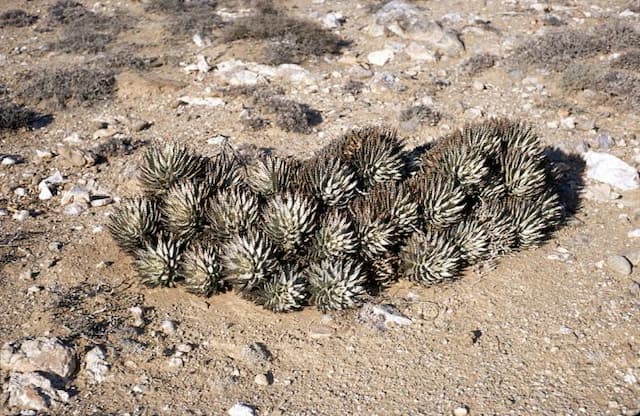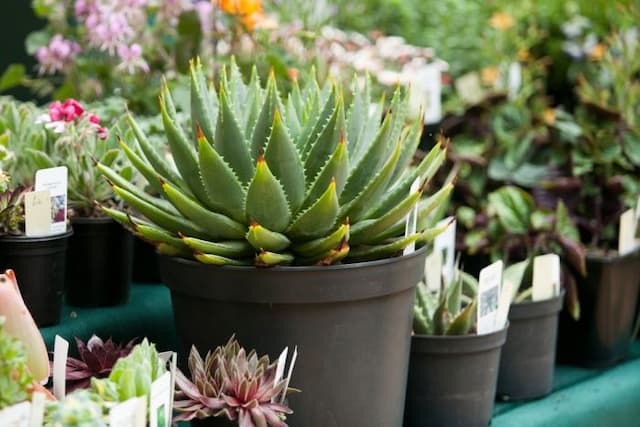Red Hot Poker Kniphofia 'Barton Fever'

ABOUT
Kniphofia 'Barton Fever', commonly known as Red Hot Poker, is a perennial plant with a striking, bold appearance. The most distinctive feature of this plant is its flower spikes, which consist of tubular flowers that display a gradient of warm colors. At the top of the spike, the flowers typically show a bright red or orange hue, which can gradually transition to a more yellow or even greenish color towards the base, creating a flame-like effect. The blooms are densely packed on the vertical flower spikes, and these vibrant inflorescences rise above the foliage like colorful torches. The leaves of the Red Hot Poker form a clump and are narrow, grass-like, and often arching. They are a rich, deep green in color, providing a nice contrast to the hot-toned flower spikes. Overall, the appearance of Kniphofia 'Barton Fever' is reminiscent of glowing embers, making it an eye-catching addition to any garden that seeks to incorporate lively colors and a tropical or exotic flair.
About this plant
 Names
NamesFamily
Asphodelaceae
Synonyms
Red Hot Poker, Torch Lily, Poker Plant
Common names
Kniphofia 'Barton Fever'.
 Toxicity
ToxicityTo humans
Red hot poker is not generally considered toxic to humans. However, as with many plants, it may cause irritation or an allergic reaction if the sap comes in contact with skin or if parts of the plant are ingested. It's always advisable to handle plants with care and keep them out of reach of small children who might inadvertently ingest them.
To pets
Red hot poker is also not commonly listed as toxic to pets. Nonetheless, ingestion can potentially lead to mild gastrointestinal upset such as vomiting or diarrhea. As pets can have individual sensitivities to plants, it's prudent to prevent them from chewing on ornamental plants, including the red hot poker. If you suspect your pet has ingested a large amount of the plant and is showing adverse symptoms, consult with your veterinarian.
 Characteristics
CharacteristicsLife cycle
Perennials
Foliage type
Evergreen
Color of leaves
Green
Flower color
Orange
Height
3 feet [0.91 meters]
Spread
2 feet [0.61 meters]
Plant type
Herb
Hardiness zones
6
Native area
South Africa
Benefits
 General Benefits
General Benefits- Attracts pollinators: Kniphofia 'Barton Fever', commonly known as Red Hot Poker, is known for attracting bees, butterflies, and birds which are beneficial for pollination.
- Drought tolerance: This plant is well adapted to handle periods of dryness once established, making it suitable for water-wise gardens.
- Low maintenance: Red Hot Poker requires minimal care once established, making it a good choice for low-maintenance landscapes.
- Visual interest: With its vibrant, torch-like flowers, it adds a unique visual appeal to garden beds and borders.
- Long blooming period: The plant has a long flowering season, providing color and interest for an extended period.
- Cold hardy: It's capable of withstanding colder temperatures, which makes it suitable for planting in various climates.
- Deer resistant: Its foliage and flowers are not typically favored by deer, reducing the risk of damage from wildlife.
- Versatile gardening uses: It can be used in perennial borders, as a focal point, or in mass plantings for dramatic effect.
- Soil adaptability: Red Hot Poker is adaptable to a range of soil types, although it prefers well-draining soil.
- Fast growth: The plant tends to grow quickly, allowing for a faster establishment and impact in the garden.
 Medical Properties
Medical PropertiesThis plant is not used for medical purposes.
 Air-purifying Qualities
Air-purifying QualitiesThis plant is not specifically known for air purifying qualities.
 Other Uses
Other Uses- The Red Hot Poker can be used as a natural dye source, providing shades of yellow and green when the flowers or leaves are processed properly.
- In garden design, it can create a dramatic vertical element due to its tall flower spikes, adding height and texture to flower beds.
- Because of their vivid coloring, Red Hot Pokers can be planted to attract and support local photography clubs or workshops, providing a vibrant subject matter.
- The long-lasting flowers of the Red Hot Poker can be used in dried floral arrangements, maintaining their shape and color after drying.
- Red Hot Pokers can serve as a biological thermometer as the blooming can indicate the start of the warm season in temperate areas.
- The plant can be incorporated into educational programs at botanical gardens, focusing on its adaptability and hummingbird-pollination mechanisms.
- As a landscape feature, Red Hot Pokers can be used to create a 'fire-effect' due to their flame-like flower spikes, especially when mass planted.
- The nectar-rich flowers can be used as a natural food source for domesticated bees in apiaries, aiding in honey production.
- Red Hot Pokers can be used in companion planting to provide shelter to beneficial insects that protect other plants from pests.
- The sturdy foliage and structure of the Red Hot Poker can be utilized in creating windbreaks or as a form of erosion control on sloped landscapes.
Interesting Facts
 Feng Shui
Feng ShuiRed hot poker is not used in Feng Shui practice.
 Zodiac Sign Compitability
Zodiac Sign CompitabilityRed hot poker is not used in astrology practice.
 Plant Symbolism
Plant Symbolism- Attraction: With its bold, fiery flowers, Kniphofia, commonly known as Red Hot Poker, symbolizes attraction and a passionate nature, drawing attention with its vibrant colors.
- Vitality: The bright and lively hues of the Red Hot Poker's blooms represent high energy and vibrancy, making it a symbol of vitality and life's zest.
- Wealth and Prosperity: The lush and abundant spikes of the Red Hot Poker can be seen as a symbol of wealth and prosperity, akin to its perceived resemblance to a torch, illuminating the path to success.
- Standing Tall: The upright growth habit of the Red Hot Poker plant signifies standing tall amidst adversities, promoting a message of resilience and strength.
 Water
WaterRed hot poker plants, including the Kniphofia 'Barton Fever', should be watered deeply once a week during dry periods, allowing the soil to dry out between waterings to prevent root rot. In areas with regular rainfall, additional watering may not be necessary. It’s best to avoid watering the foliage directly to prevent fungal diseases. Instead, water at the base of the plant. A good rule of thumb is to provide about one inch of water per week, whether through rainfall or manual watering. During particularly hot and dry spells, you may need to increase watering to twice a week.
 Light
LightRed hot poker plants thrive in full sun conditions, requiring at least 6 to 8 hours of direct sunlight daily. The Kniphofia 'Barton Fever' should be positioned in a spot where it can receive uninterrupted sunlight for optimal growth. This plant will tolerate some light shade, especially in hot climates, but too much shade can lead to poor flowering and lanky growth. Ensure that any nearby plants or structures do not cast excessive shade on the Kniphofia 'Barton Fever'.
 Temperature
TemperatureRed hot poker plants like Kniphofia 'Barton Fever' do well in a range of temperatures but prefer warm weather. They can tolerate temperatures down to about 10°F but grow best in temperatures between 50°F and 85°F. Extreme cold can damage the foliage, so in areas with harsh winters, applying a layer of mulch can provide additional protection. Red hot poker plants are generally not suited for climates where temperatures remain high throughout the night for prolonged periods.
 Pruning
PruningPruning red hot poker plants like Kniphofia 'Barton Fever' is mainly done to remove spent flower stalks and tidy up the plant. Deadheading encourages more blooms and prevents the plant from self-seeding. Prune dead or damaged foliage in the spring. Annual pruning is typically sufficient, and the best time for general maintenance is late winter to early spring before new growth starts.
 Cleaning
CleaningAs needed
 Soil
SoilRed Hot Poker ('Barton Fever') thrives in well-draining, fertile soil with a pH range of 6.0 to 7.0. A mix of loam, compost, and sharp sand or perlite to enhance drainage would be ideal for this plant to flourish.
 Repotting
RepottingRed Hot Poker ('Barton Fever') generally does not require frequent repotting and can be repotted every 2-3 years or when it outgrows its container.
 Humidity & Misting
Humidity & MistingRed Hot Poker ('Barton Fever') is not particularly humidity-sensitive and prefers average garden conditions, tolerating dry to moderate humidity levels well.
 Suitable locations
Suitable locationsIndoor
Provide full sun through a window and well-draining soil for Red Hot Poker.
Outdoor
Plant in full sun, well-draining soil, and space for clump growth.
Hardiness zone
6-9 USDA
 Life cycle
Life cycleRed hot poker 'Barton Fever' begins its life cycle as a seed, which, when sown in well-drained soil and given proper warmth, will germinate. The seedling stage is characterized by the emergence of a few grass-like leaves, as the plant establishes a root system. It then enters a vegetative phase, producing clumps of strap-shaped foliage and gradually maturing over the course of several months. The flowering stage occurs when a tall flowering spike grows from the center of the clump, displaying tubular flowers that start blooming at the bottom of the spike and progress upward; typically, this occurs in the summer. After pollination, the flowers fade, and seed capsules may form, containing seeds that can contribute to the propagation of the species. The plant then goes dormant, with the foliage often dying back in colder climates, only to regrow the following spring to restart the cycle.
 Propogation
PropogationPropogation time
Spring to early summer
Kniphofia 'Barton Fever', commonly known as Red Hot Poker, is most effectively propagated by division. The ideal time for this process is in the spring, just before the plant begins its active growth. To propagate by division, carefully lift the mature clump from the ground with a shovel and gently separate the crowns, ensuring that each division has a good portion of roots attached. Replant each division immediately at the same depth it was originally growing, and water thoroughly to establish. This method helps to rejuvenate older clumps, maintain plant vigor, and increase the number of plants in the garden.









